Find out in the article when and how to plant, how to care, water, feed, cut the blackberry.
Content
- When it is better to plant a blackberry - in the spring or autumn: tips and recommendations for choosing seedlings
- The choice of a place for planting blackberries, preparation and fertilizer of the soil, good predecessors of blackberry
- How to plant a blackberry at what distance and at what distance?
- Video: Growing blackberries
- A method of growing blackberries on a trellis: how to make a trellis with your own hands?
- Video: Robler for blackberry with your own hands
- Black Bleet varieties: Which one to choose?
- Caring for a blackberry in the first year of landing: watering, top dressing, is it necessary to pinch the blackberry?
- How to tie a blackberry on a trellis correctly: the formation of a bush, a garter scheme
- Video: Formation of Black Black Bill on a Schpaler
- Features of blackberry trimming: Terms
- Is it possible to plant a blackberry next to raspberries?
- How to propagate blackberries - methods: propagation of blackberries with seeds, apical layers, cuttings, division of the bush, root offspring
- Blacks' diseases and pests: description with photographs and struggle measures
- Rules for planting blackberries in the fall
- Care for blackberry in the fall, preparation for winter
- Video: Autumn landing and shelter of blackberries
- When, for what year does the blackberry begin to bear fruit?
- Why doesn't the blackberry bear fruit: reasons, what to do?
- Video: Black Black Council tips
When it is better to plant a blackberry - in the spring or autumn: tips and recommendations for choosing seedlings
Tasty Berry Berry is from America. In central Russia, blackberries are not grown as often as raspberries. Although these are related crops. Blackberry is less frost -resistant than raspberries. Therefore, gardeners often do not risk starting it in their areas. Black blackberries can be found in the wild. The taste of blackberries like many, but besides taste, the berry is very useful. Therefore, its popularity, like garden culture, is growing.
Important: blackberries can be planted in spring and autumn, it all depends on the region. For the northern and central regions of Russia, spring landing is suitable, for the southern - autumn, but can also be planted in the spring.
The spring planting of the blackberry falls at the end of April - early May, when the soil is completely warmed up and there will be no threat of frosts.
In order for the blackberry to please a good harvest, one of the important conditions is the right choice of seedlings.
How to choose seedlings:
- When buying seedlings, pay attention to the root system: it should be well developed. Be sure to have 2-3 roots with a length of 10 cm.
- The roots should be wet or with a lump of earth.
- A kidney must be formed on the roots.
- If the bark is wrinkled, it means that the seedling has long been smuggered and can take root poorly.
- There should be 1-2 stems on the seedling.
- To check the suitability of the seedling for sure, cut a piece of bark. If the fabric is juicy, green - everything is in order, if brown - the seedling is poor -quality.

The choice of a place for planting blackberries, preparation and fertilizer of the soil, good predecessors of blackberry
Blackberry will grow well and bear fruit in sunny areas. Do not plant bushes in the shade, there they will take root, but the crops will be weak.
The place should not be pierced by the wind, since gusts of wind can damage a delicate plant. In addition to injuring leaves and berries, the wind can harm during the pollination of the flowers. The most suitable place for blackberries is the southern and western sections.
The blackberry is undemanding to the soil, but does not like carbonate soils. On such soil, the plant will not receive a sufficient amount of substances such as magnesium and iron, because of which it can get chlorosis. Soils such as loams, sandyards, chernozem, are ideal for planting blackberries.
Good predecessors For blackberries are the following crops:
- Legumes
- Vegetables
- Field
- Siderates
Bad predecessors: Berries and nightshail weapons.
Important: if you constantly introduce fertilizers to the soil on your site, no additional actions before planting blackberries are required. Excessive fertilizing can lead to increasing greenery blackberries, which will harm the berries. In autumn, the plot allotted for blackberries is treated from diseases, cleaned of weeds and pests.
If the soil was planted with poor predecessors, the upper soil layer when digging pits for planting blackberries is mixed with such fertilizers:
- Organics - 10 kg;
- Phosphates - 15 g;
- Potassium fertilizers - 25 gr.
The number of fertilizers is indicated per 1 m² of site. Then, this layer of soil with fertilizers is sprinkled with seedlings of seedlings.
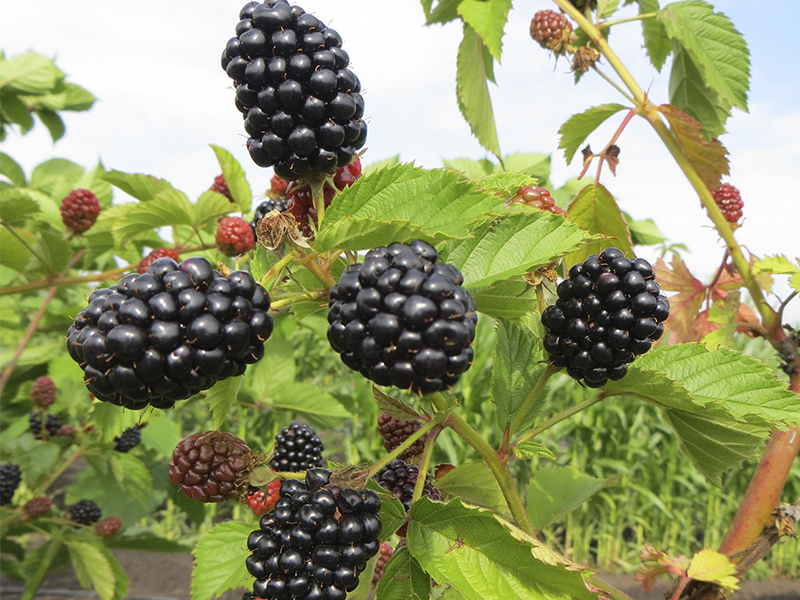
How to plant a blackberry at what distance and at what distance?
Black blackberries are planted at the supporting structure. Prior to the start of landing, they outline the scheme of the blackberry. Wooden or metal pillars are driven. If the variety is straightforward, the support is placed on the side of the bush. For creeping varieties, the supporting structure is a trellis about 2 m high.
Planting a seedling it is produced in this way:
- Make pits or furrows for seedlings. The seedling should be deepened into the ground by 7-8 cm.
- A prerequisite is the location of the kidney underground at 2-3 cm. Therefore, adjust the depth of the pit yourself based on the above two rules.
- Lower the seedling into the pit, straighten the root system, pour a layer of soil with fertilizers.
- The soil is not covered at the surface level, they leave a small hollow of several centimeters.
- The soil should be compacted and water with water in calculation of up to 6 liters for each seedling.
- After the water is absorbed, the holes are mulched in organicism or straw.


Important: when planting a seedling, blackberries are cut off so that the escape is 20 cm above the surface. Fruit branches are removed.
The yield of blackberries largely depends on the density of planting seedlings. The seedling should have enough power area, as the seedlings grow rapidly and, despite the pruning, can interfere with each other.
For each variety, you should withstand different distances between plants:
- For straight-growing varieties-1.5-2.5 m;
- For creeping - at least 2.5 m, preferably up to 3 m.
For large plantations, blackberries with a limited area of \u200b\u200bthe gardeners adhere to a distance of 1 m, between rows - 2 m. For the content of such a plantation, enhanced care is required: top dressing should be carried out more often than in nurseries with a large distance, drip irrigation should be organized.
Video: Growing blackberries
A method of growing blackberries on a trellis: how to make a trellis with your own hands?
Such a device as a trellis must be installed for creeping varieties. Spaler is supports in the form of pillars with rows of wires stretched in a horizontal position.
The use of trellises greatly simplifies the care of the plant, promotes proper development.
Advantages of using trellises:
- Easy to form a bush;
- Easy to care, remove dried branches;
- Berries do not get dirty in the ground;
- It is convenient to make fertilizers;
- Blackberry takes a minimum of space.
- Berries receive enough sun, light and air.
- The harvesting is faster and more convenient.
There are single -lane and two -lane trellises. Single-lane is often used by amateur gardeners, and two-lane gardeners on large plantations.
In its turn, single -lane trellises It has various designs:
- Fan;
- Vertical flat;
- Horizontal;
- Free;
- Inclined.

Double -lane trellises also has various designs and the type:
- T-shaped;
- V-shaped;
- Y-shaped.

Can make trellises yourself, for this you will need the following materials:
- Wooden or metal supports about 2 m high.
- Strong wire.
How to install:
- First, you need to dig on the opposite sides of the quarter of the hole for the installation of pillars. A sufficient depth is about 60 cm.
- If a long blackberry is supposed, several supports should be installed at a distance of about 5 m.
- A layer of broken brick should be poured to the bottom of each pit so that the pillars do not sag in the future.
- Set the supports, fill them with ground tightly.
- Pull three rows of wire. The distance between the rows of wire should be approximately 60 cm. The wire should be pulled tightly so that it does not sag.
- When the blackberry will grow, she will have to be tied to the wire.
Video: Robler for blackberry with your own hands
Black Bleet varieties: Which one to choose?
Blackberry got its name from the word "hedgehog" because of her thorns. The breeders brought new varieties of blackberries without spikes, which give a good harvest and frost -resistant.
Important: knowing the features of the variety, you can easily choose the right for the climatic conditions of your region.
Popular varieties of blackberries:
- Chester. It can withstand frosts up to –26 ° C. A half -standing shrub needs a garter to the trellis. The berries are dense, which allows them to be stored and transported for relatively long. The variety has high productivity. The taste of berries is sweet with sourness, size-medium and large berries weighing about 5-7 g.
- Apachi - The variety does not tolerate frosts, it needs shelter. He does not like drought, drip irrigation is required. The berries are very large (one berry weighs about 10 g), black with glossy shine. The berries do not crumble, they keep their appearance for a long time. The berries do not deteriorate if they are not torn from the bush for a long time.
- Karaka Black. Resistance to frost, pests, diseases - average. The variety is characterized by large long berries. This variety is a successful result of crossing blackberries with raspberries. The leaves of this variety may turn yellow, and this is not a sign of the disease.
- Ruben. A variety with vertical bushes that do not require support. The variety is frost -resistant, fruiting continues until autumn frosts.
- Black Satin. Variety without spikes. It is distinguished by powerful and strong bushes that reach a height of 2-3 human heights. Berries of this variety are recommended to be collected immediately after ripening, within 3 days, as they quickly crumble.
- Thornfrey. Unpretentious and frost -resistant variety. The bush can grow up to 30 years. The berries are delicious, dessert. There are no spikes.
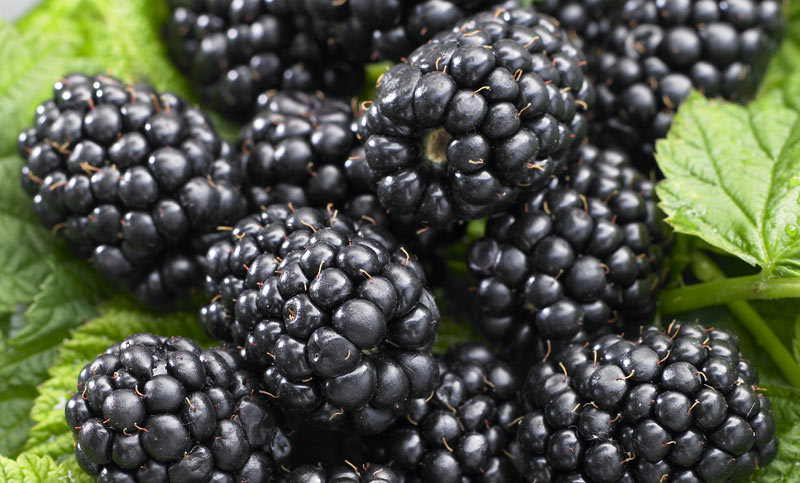
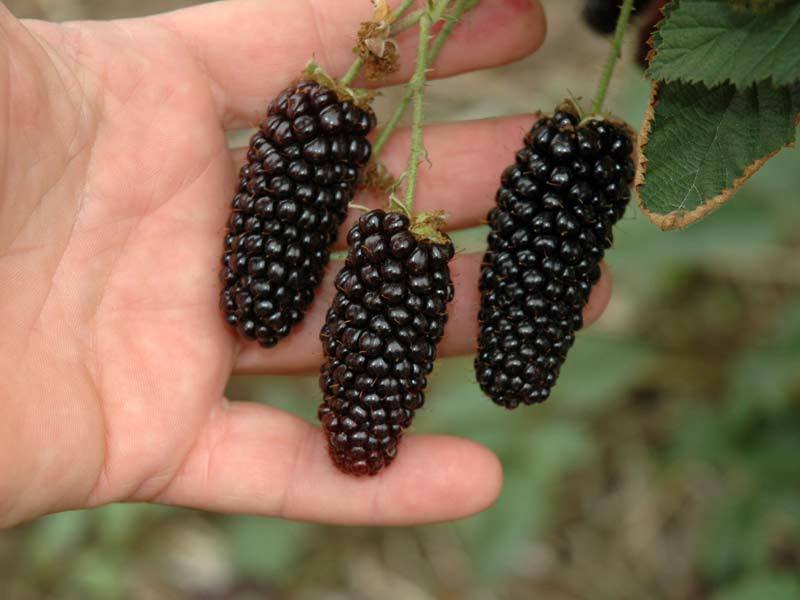
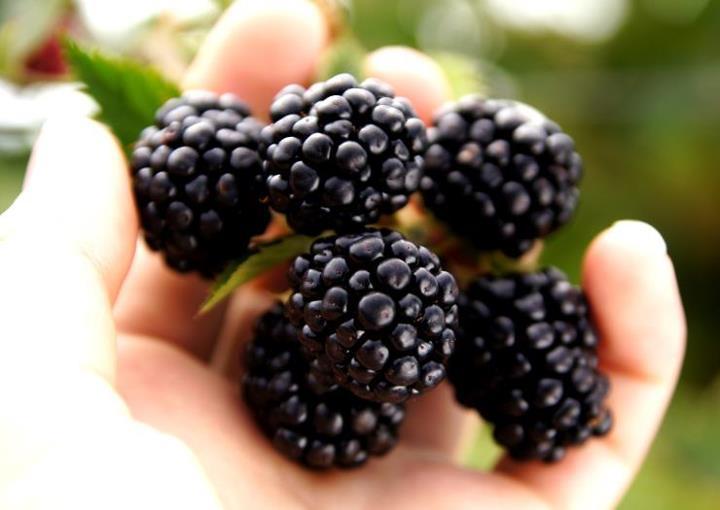
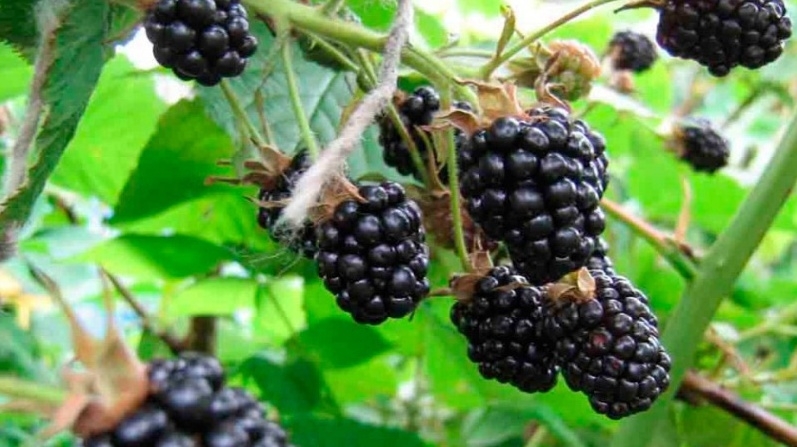
Caring for a blackberry in the first year of landing: watering, top dressing, is it necessary to pinch the blackberry?
Important: after planting, the blackberry does not bear fruit and does not bloom in the first year.
The soil around the blackberries loosen and get rid of weeds. The soil should not be loot deep. Blackberry loves moderate watering. In drought, the bushes should be watered once a week. Watering It is also required during flowering and when ripening berries. However, you should not be zealous, excess moisture can destroy the bush. Water the blackberry should not be cold water. For irrigation, water or rain is suitable in the sun. Install a barrel on the site to always have a reserve of rain water
If before planting in the soil were introduced necessary fertilizers, additionally fertilizing the soil does not need to be for 2 years. In the third year, such fertilizers are introduced:
- In the fall, organics are applied, if you use manure for mulching, you do not need to make phosphates. If you do not use organics, 50 grams of phosphates per 1 m² are introduced in the 3rd year.
- In the spring during the growing season, nitrogen fertilizers are added - urea or ammonium nitrate of 20 g per 1 m².
- In summer - complex fertilizers. Blackberry also needs potassium fertilizers without chlorine.
A straight -growing blackberry needs pinzing or pinching:
- If the main escape grows to 1-1.2 m, 10 cm of the top is cut.
- If the side shoots reach a length of 50 cm, they are also slightly shortened.
This makes it possible to form a beautiful bush without reducing productivity.

How to tie a blackberry on a trellis correctly: the formation of a bush, a garter scheme
Creeping varieties, as the branches grow, are necessarily tied to the trellis.
There are different ways to garter blackberries:
- Fan
- Weave
- One -sided tilt
At a fan method The overgrown shoots are diluted and tied to the wire. Young branches are tied to the lower tiers of the wire.
With a method weave Black blackberries intertwine between three tiers of wire. Those shoots that grew after forming are made in different directions from the center of the barrel.
At one -sided inclination Shoots are directed to 2 lower rows of wire. After growing, the shoots are removed to the upper row of wire. Shoots are placed on the right and left.

Important: dried and weak shoots remove.
Video: Formation of Black Black Bill on a Schpaler
Features of blackberry trimming: Terms
IMPORTANT: Cutting blackberries is carried out almost all year round: in the spring, summer and autumn. If you decide to breed a blackberry, be sure to get a good secateur.
Spring Pruning is carried out until the kidneys are formed. Remove all the frozen shoots, broken parts of shoots. Young bushes need pruning in May and July. In May, the tops are cut by 5 cm, in July-side processes, which grew to 50 cm, are reduced by 5-7 cm. In addition, they leave no more than 6 strongest lateral shoots, others, weaker, are cut off.
In adult bushes, except for broken branches, all weak are removed. No more than 10 strongest shoots should remain on the bush. The side branches are shortened by 20 cm.
Summer All new root shoots are cut off, only spring is left.
In the fall The branches are cut, leaving a height of about 2 m. Also, all weak branches are cut in the fall. All shoots of the second year are cut off after their fruiting, there will no longer be berries on them, so you should not spend strength on their food.
Is it possible to plant a blackberry next to raspberries?
The blackberry can be placed next to raspberries. Keep in mind that both raspberries and blackberries are creeping plants. If you plant them in a small garden, then they can braid it completely. Be prepared to regularly thin out the garden.
How to propagate blackberries - methods: propagation of blackberries with seeds, apical layers, cuttings, division of the bush, root offspring
The blackberry is propagated in different ways, for some species, reproduction by apical and horizontal layering is acceptable, other varieties are propagated by root offspring.
Below are the main ones methods of reproduction:
- One of the simplest and most unpretentious ways is reproduction apical layering. In the spring, a long shoot is bent to the ground, and the top is filled with the soil. Roots and young processes will soon go from this top. The new escape can be separated from the maternal when strong processes appear.
- Horizontal layering It is carried out by sprinkling with soil along the entire length of the shoot. Several new plants grow from a long shoot, then young shoots are separated and separated from the mother's bush.
- Root offspring They grow around the bush. The most powerful dug and transplant. The transplantation of root offspring is approximately in May-June.
- When there are no root offspring, use the method propagation of the bush. The entire bush is dug up and separate well -developed parts. The old root is disposed of.
- Reproduction cuttings Used for a brood of valuable varieties. In the summer in June-July, a third of the upper shoot is cut off. Then cut the cuttings in which there should be such parts: stem, kidney, sheet. Cuttings are planted in glasses and kept under a shelter for about a month. Then, when the cuttings have roots, transplanted to a permanent place.
Less commonly propagated by blackberries seeds, segments of roots, air layering. These methods are quite complex and do not always give a positive result.



Blacks' diseases and pests: description with photographs and struggle measures
Blacks and raspberries have general diseases and pests. Consider them.
Blackberry diseases
- Anthracnosis. A fungal disease that affects shoots, leaves, berries. The defeat can be determined by the presence of gray round spots. With damage to anthracnosis, the berries develop one -sidedly, dry out. The cause of the disease is a strong thickening of plants in conditions of high humidity.
- Gray rot. The development of the disease is facilitated by rainy rainy weather. When the blackberry is affected by gray rot, its inflorescences and berries rot, shoots die off. In winter, cracks with black fungal deposits are visible on the affected stems.
- Rust. The disease can be recognized by the characteristic color of the leaves. Their inside is covered with orange pustules, the outer side of the sheet has a weak color. The affected shoots bloom, do not bear fruit, gradually the plant is dying out.
- Chlorosis. All parts of the plant turn yellow, the fruits become small and not at all tasty. The plant loses frost resistance.
- Powder. The disease develops in the first half of summer, the young parts of the plant are affected. In the affected areas, you can observe a white or grayish plaque. The shoots grow weakly, the berries are smaller.



Black blackberry pests
- A raspberry beetle. A gray-black beetle covered with hairs. Winters in the soil, and in the spring moves to the flowers of raspberries and blackberries. It eats both leaves and flowers, berries. The female lays eggs in the flowers and on the ovaries, hatching larvae eat the ovary.
- A raspberry stem fly. Years of flies coincides with the growing of young shoots. Females lay eggs on young shoots, and the hatched larvae gnaw off the shoots. Powering with larvae of shoots leads to drying and dying of part of the plant.
- Blackmary tick. It is impossible to notice it with the naked eye. Blacks in the kidneys winter in the kidneys. In the spring they move to shoots, and then to flowers and berries. Because of the tick, the berries do not ripen, as expected, lose their taste and look. Sometimes a tick can destroy up to 50% of the crop.
- May Khrushchi. They eat leaves. In winter, they go under the soil and gnaw the root system of the plant.
- Raspberry Gallitsa. Another small pest that is activated during the flowering of the blackberry. Gallician defeat oppresses plant growth.



To protect your blackberry from pests and diseases, it is necessary in the spring before the buds and autumn after collecting blackberries to spray the plants. Suitable such drugs:
- Aktellik
- Karbofos
- Fitoverm
- Akarin
You should also thoroughly loosen the soil, fight weeds, thin out the blackberry, dispose of dried shoots.
Rules for planting blackberries in the fall
In the fall, blackberry can be planted in the southern regions with warm winters. Young seedlings may not transfer the harsh frosty winter. In a hole during autumn planting, blackberries are added humus.
If in winter the snow cover is about 60-70 cm, then you do not need to cover young seedlings. Snow cover of such a height is enough to cover the plant. If there is no snow, it is better to cover the Sazhan residents with agrofibre or other covering material. You need to do shelter during the last cooling, before the onset of frost, so that the plant does not give horizontal layering.
Important: to complete the autumn planting of blackberries until mid -October if the weather is good. Blacks in September begin the autumn landing.
If the blackberry, planted in the fall, is well wintering, you can get the first crop earlier than from a blackberry planted in the spring.
Care for blackberry in the fall, preparation for winter
In the fall, the blackberry should be cleaned of dry shoots, dig the soil between the rows. Before frosts, the blackberry should be well watered.
The most important thing in preparing for winter is to cover the plants. Adult plants on blackberries tolerate frost hard. Although many varieties of blackberries are frost -resistant, they are covered for the winter. For this, blackberry bushes are binded and tilted to the ground.
In order not to break the branches, the plant is thrown through the knee. Then the blackberry is hidden by one or two layers of agriculture. Fix the covering material with bricks or other heavy objects. Also, they make a flooring of coniferous branches on top.
Video: Autumn landing and shelter of blackberries
When, for what year does the blackberry begin to bear fruit?
In the first year of life, the blackberry does not give fruits; during this period, the kidneys are laid. In the second year, the blackberry begins to bloom and gives fruits. The shoots that were sprouted will no longer give berries, they die. Therefore, they should be eliminated. In parallel, the shoots of replacement grow from which the bush is formed. The owner himself plans and forms the development of a blackberry bush.
There is also a repair blackberry that bears fruit in the first year after planting. In autumn, all shoots are cut off, and new ones grow in the spring.
The blackberry blooms in June, and matures in the middle of summer, in the late summer. But there are also early varieties that give the crop in June. Gardeners do not really like such varieties, as they are susceptible to frost. Freezing during flowering destroy the crop. Late vegetable varieties can enjoy in September.
Why doesn't the blackberry bear fruit: reasons, what to do?
The main reasons why the blackberry does not bear fruit are:
- Freezing of a blackberry. Insufficient shelter for the winter can lead to the fact that the plants will die and will not bloom in the spring, therefore, there will be no crop. If the blackberry froze, you should not destroy it, with the right agricultural technology, you can get a crop for the next year from new shoots. Sometimes the plant cannot be restored.
- Moisture lack. Young seedlings, plants during flowering and ripening of fruits need watering.
- Lack of fertilizers. If you did not make any fertilizers when landing, or many years after the last top dressing passed, there will be no crops.
- Damage to blackberries with diseases.
- Incorrect care and the formation of a bush. The blackberry will not bear fruit and give abundant crops if there is a thickening, if all the branches do not receive enough sunlight.
To receive good yields, it is necessary to process the soil, in time she can cover the blackberry with reliable shelter, thin the plants and tie branches to the supports.
Blackberry bush can grow and bear fruit in one area for many years. Blackberry is responsive to top dressing, for proper care. Subject to all requirements, you can get stably high yields of delicious and healthy berries.







